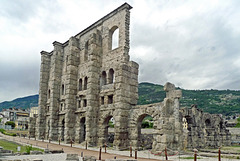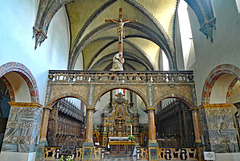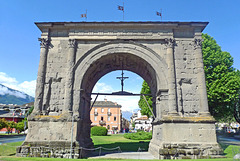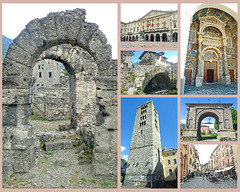Jaap van 't Veen's photos
Nederland - Gouda, stadhuis
| |
|
|
|
Gouda received city rights in the year of 1272. In 1448-1450 the town hall was built. Now it is considered being one of the oldest Gothic town halls in the Netherlands. The building was designed by architect Jan III Keldermans, from the famous Flemish Keldermans family of architects, who were also responsible for several other city halls and churches around the Netherlands and Flanders.
In the summer of 1438, a major city fire caused serious damage to the town hall. The city council decided that the new town hall should be free and chose the market square - then still a swampy peat bog - as the new location. The town hall is located on the Market Square, one of the largest market squares in the Netherlands. Over the past centuries, the town hall has been altered and rebuilt many times. It was originally surrounded by a moat, which was filled up in 1603. In the 17th century, a staircase was added to the town hall, leading to the building itself and to the balcony on the rear façade.
The town hall - still the landmark of Gouda - can be visited during weekdays given that there are no wedding ceremonies.
Belgium - Sippenaeken, Castle Beusdael
| |
|
|
|
Castle Beusdael is located outside the village of Sippenaeken. The castle - surrounded by a moat - is characterized by three main parts: an imposing limestone tower, dating back to the 13th century (12 meters wide and up to 28 meters below the cornice with thick walls 1.5 to 2.5 meters at the base), the main building in stone and bricks from the 16th century, and finally the neo-Gothic chapel of the late 19th century. To enter the castle, you cross a stone bridge over the moat with a gate building.
The first Lords of Beusdael appear in the 14th century. This family was powerful and owned several properties, like the Dutch castles of Geusselt and Goedenraad. By marriages and heritages the Castle Beusdael transferred from the Van Beusdael family to a lot of noble families until the 19th century. In 1875 it was inherited by Count Florent d'Oultremont, who ordered major alterations to the castle.
Castle Beusdael had several other owners until it was bought by the Antoine family in 1976. The castle is private property and still inhabited and not accessible.
Nederland - De Goudse Waag
| |
|
|
|
De Goudse Waag (Gouda Weighing House) is a monumental historic building dating from 1668, designed by the well-known Dutch architect Pieter Post. Gouda was an important transit point between Amsterdam and Rotterdam. All goods weighing more than 10 pounds were weighed at De Goudse Waag , and duty then needed to be paid on them.
The ground floor of De Goudse Waag - formerly used to weigh cheese - nowadays houses the tourist information center of Gouda. Further on it is home of the Cheese and Crafts Museum. Here, one can learn about the building’s history, the products weighed and traded, and how cheese is made.
Nederland - Delft, De Roos
| |
|
|
|
Windmill De Roos (The Rose) is located on the former city wall of Delft. The mill was built in 1679 on a roundel, a semi-circular defensive structure. A wooden post mill had already been standing on the same spot since 1500. This mill is the only remaining mill of the eighteen windmills in Delft.
Originally De Roos was also made of wood. In steps, it was converted into a brick one, which gave the mill a special shape. For instance, the substructure is hexagonal and the superstructure round. In 1728, the dwelling house was built in a semicircle around the mill. Around 1760, the mill looked as it does today.
The mill was in bad shape in the early 1980s. It was crooked due to a subsidence in 1929 and the cap was badly affected by a beetle. In 1988, the mill was refurbished and the superstructure straightened.
Windill De Roos is still used for grinding flour; since spring 2015 it is grinding organic grain for private individuals, bakers and the catering industry. The mill is turning a couple of days a week and can be visited.
Italy - Aosta, Teatro Romano
| |
|
|
|
Teatro Romano (Roman Theatre) was built in the late reign of Roman emperor Augustus, some decades after the foundation of the city (25 BC). It was extended two centuries later. The theatre occupies three blocks annexed to the ancient city walls, along the Roman main road structure occupied an area of 81 by 64 meters. One can still identify its semi-circular tiers, the orchestra pit, and the stage wall, which was once raised with decorated columns, marble and statues. The theatre could hold as many as 4.000 spectators.
Today the southern façade - perforated by arches and windows - still remains. The wall has a height of 22 meters. The cavea was enclosed in a rectangular-shaped wall including the remaining southern part. This was reinforced by buttresses each 5.5 metres from the other, and included by four orders of arcades which lightened its structure.
In the Middle Ages, the original function of the theater was forgotten and different constructions began to grow around it. Their demolition was proposed in 1863 , but the process finally completed between 1933 and 1941.
Nederland - Ootmarsum, stadhuis
| |
|
|
|
One of the most prominent buildings in Ootmarsum is the (former) town hall with its beautifully decorated facade and with the town coat of arms above the entrance. The town hall was built in 1778 on the same site where the Huys der Stadt had also stood since 1564. The new town hall was designed by architect Egbert Schrader.
It became a town hall without a turret. A copper weather vane was put on the ridge of the roof. Only much later - in 1839 - was a turret put on the town hall.
Ootmarsum was a separate municipality until 2001, when it became a part of Dinkelland. Two years later, the town hall was sold by the new municipality. The building then had various functions, but as a national monument it will always remain in Ootmarsum.
Nederland - Delft, stadhuis
| |
|
|
|
The first construction of the town hall in Delft dates back to 1200. In 1400, it was rebuilt or remodelled. In 1618 the town hall burned down. It was then rebuilt to a design by Hendrick de Keyser - a famous Dutch architect - in 1618-1620.
Over the centuries the town hall was modified several times. In the process, the double staircase to the main entrance had to give way, the main entrance was widened at the cost of two windows, and the shutters and stained-glass windows disappeared. In the 20th century, the town hall was restored under the direction of architect Jo Kruger, and is now back to the state of Hendrick de Keyser's design in the Dutch Renaissance style.
The town hall was the former seat of the city council; nowadays it is still used for wedding ceremonies. The building is an important landmark of Delft.
Italy - Aosta, Collegiata di Sant'Orso
| |
|
|
|
The Collegiata di Sant'Orso (Collegiate church of Saint Ursus) is dedicated to Saint Ursus of Aosta. The original church - dating back to the 5th century - had a single hall. It was entirely rebuilt in the 11th century, during the Carolingian age. Later the church was further renovated into a basilica plan with three naves with wooden trusses. These were replaced by Gothic cross vaults in the 15th century.
The church has a quite simple interior with 11th century Ottonial frescoes and a wooden choir. It is also home to numerous missals and reliquaries, including the relics of Saint Ursus, which rest in the crypt.
The Romanesque cloister (PiP3) is another religious building in the Saint Ursus complex. Its construction dates back to the 12th century. The cloister has historiated capitals (PiP4), decorated with fantastic beasts, biblical events and scenes from the life of Saint Ursus himself. 37 of the 42 original capital remains: they were originally in white marble, though now they mostly appear in dark gray color after being washed with ash paint.
Opposite the entrance of the collegiate church stands the imposing bell tower (PiP5), 46 meters tall. Originally it was a defense tower dating back to the end of the 10th century. The present structure, in Romanesque style, dates to the 12th century
Nederland - Ootmarsum, H.H. Simon en Judaskerk
| |
|
|
|
The H.H. Simon en Judaskerk (H.H. Simon and Jude Church) is a Roman Catholic, dedicated to the Apostles Simon and Jude Thaddaeus. The church is the only example in Westphalian Romanogothic style in The Netherlands. Although already mentioned in 1162, it largely dates from the 13th century.
During my visits to Ootmarsum, I had seen the church several times. This time I was also able to take a look at the interior. It made an overwhelming impression from the moment I stepped inside. Due to a concert about to start, it was very busy with people in the church and taking (good) photos was almost impossible. Hence just a few pictures of the interior/the beautiful main altar in the choir.
Nederland - Schiedam, Korenbeurs
| |
|
|
|
The 18th century was Schiedam's Golden Age: the cessation of liquor imports from France made possible the emergence of the Schiedam gin distillery. Jenever from Schiedam was exported all over the world from dozens of distilleries and distilleries. The jenever industry gave Schiedam the nickname 'Black Nazareth', because the soot from the distilleries and glass factories colored the city black.
The Schiedammer Korenbeurs (Corn Exchange) or Koopmansbeurs is a Dutch national monument, which was built between 1786- 1792. Malt wine, grains and alcohol were traded in the Korenbeurs . This trade was directly related to the Schiedam distilleries for jenever.
The building has been repaired and renovated several times over the years. Since 2015 the building houses the public library of Schiedam. The covered courtyard has become a courtyard garden, a green atrium with tall trees and plants. The library has a reading table with a remarkable chandelier, made of dozens of gin glasses
Italy - Aosta, Cattedrale di Santa Maria Assunta e…
| |
|
|
|
The Cathedral of Santa Maria Assunta e San Giovanni Battista (Cathedral of the Assumption of Mary and Saint John the Baptist) is the most important and oldest religious building in Aosta. The church was founded at the end of the 4th century, when a Roman complex was converted into a Christian place of worship.
At the end of the 15th century and the beginning of the 16th century, a series of works on the body of the building gave it the appearance it still has today, such as the Renaissance-style façade built between 1522 and 1526, decorated with frescoes and terracotta sculptures.
The ïmpressive original structure of the cathedral was modified in the 11th century. The cathedral is rich in art and religious treasures: a precious cycle of 11th-century frescoes that decorate the vault was discovered in 1979, while the interior of the cathedral houses, among other things, a wooden crucifix from 1397, valuable artistic stained glass windows made between 1400 and 1500. The high choir, dominated by a crucifix of the fourteenth century, has thirty wooden stalls dating from 1469.
The building dominates the city thanks to its two bell towers, which with 60 meters in height are the tallest buildings in the entire Aosta Valley.
Nederland - Ootmarsum, H.H. Simon en Judaskerk
| |
|
|
|
The H.H. Simon en Judaskerk (H.H. Simon and Jude Church) is a Roman Catholic, dedicated to the Apostles Simon and Jude Thaddaeus. The church is the only example in Westphalian Romanogothic style in The Netherlands. Although already mentioned in 1162, it largely dates from the 13th century.
In 1491-1492 a new late-Gothic choir was added, followed by a second transept east of the old one. Except for one window above the south portal, all windows have been enlarged. The entire church is built of Bentheimer stone.
From 1626 until 1809 the church was used by the Protestants. In that year King Lodewijk assigned the church building to Roman Catholics, as the Protestant congregation was much smaller. When it was returned to the Catholics, it was in a bad state. The original Romanesque tower was replaced by a new facade and a small wooden tower in 1842.
Nederland - Delft, Oostpoort
| |
|
|
|
The Oostpoort (Eastern Gate) is an example of Brick Gothic architecture. Its twin towers flank an entrance moat and bridge. The gate was built around 1400. In the 16th century they were raised with hexagonal floors and high pointed spires. The gate is located in perhaps one of the most enchanting corners of Delft. The Oostpoort was once known as “Saint Catherine’s Gate” and is the eldest medieval entranceway to Delft.
Originally there were nine gates to Delft. Eight were demolished by 1847. The Oostpoort is the last remaining gate in the city. The gate consists of a land-gate and a water-gate that are connected by the remains of the city wall.
The Oostpoort was last restored in 1962-1964. Nowadays it serves as an art gallery and private residence.
Italy - Aosta, Arco di Augusto
| |
|
|
|
The Arco di Augusto (Arch of Augustus) was erected in 25 BC on the occasion of the victory of Rome over the Gallic tribe, calles the Salassi and founding the new colony.
The arch has a single vault, with a height to the keystone of 11,4 meters. Its span is a barrel vault, constituting an extension in width of a round arch, measuring 8,3 meters. The monument, which changed during centuries, consists of a single round arch framed by half-columns and surmounted by Corinthian capitals and crowned by a Doric trabeation.
The arch's modern appearance is the result of a final intervention for restoration and consolidation which occurred in 1912. The wooden crucifix displayed below the vault is a copy of the one which was placed there in 1449 as a votive offering against the flooding of the river Buthier, which flows a little to the east.
Emperor Augustus name adorns not just the arch, but also the region itself: "Aosta" is a derivative of Augustus.
Nederland - Maastricht, Helpoort
| |
|
|
|
The Helpoort (Hell’s Gate) - also known as Jekerpoort, Hoogbruggepoort, Alde Poort op den Ancker, Kruittorenpoort or De Twee Towers - is part of the original medieval city wall. Hendrik I, Duke of Brabant - gave permission for its construction in 1229. For about two centuries, the gate was part of the city's actual fortifications. It lost this function when the Nieuwstad (New City), the area south of the gate, was surrounded by a wall in the second half of the 15th century.
The Helpoort - a Dutch national monument - is the only remaining city gate in Maastricht and the oldest city gate in the Netherlands. The sandstone towers are more than 14 meters high (when included with the towers the height rises above 20 meters). Through the gate one reaches the Sint Bernardusstraat, lined with many monumental buildings (PiP2).
Nederland - Stedelijk Museum Schiedam
| |
|
|
|
Stedelijk Museum Schiedam (Municipal Museum Schiedam) was founded in 1899 and has been located in the Dutch national monument Sint Jacobsgasthuis since 1940. (A gasthuis is a combination of retirement home and hospital, a place one can visit from the age of 40.)
This hospital was built in 1787 in a symmetrical, neo-classical style after a design by architect Italian Jan Guidici. It was built on the site of an even older hospice which was founded around 1547. The property housed poor elderly people until 1934 and that function is apparent from its floor plan: in the centre of the building there is a large chapel with a wing on either side. The left wing was used as a men's wing and the right as a women's wing.
After a renovation (2013) the former neoclassical chapel (PiP) has been transformed into the main entrance for the museum. It also houses a café and a museum shop.
Nederland - Schiedam, Appelmarktbrug
| |
|
|
|
The Appelmarktbrug is one of Schiedam's three cast-iron drawbridges, built around 1860. When a boat passes through the harbour, this bridge is pulled up by hand by two bridge keepers. The cast-iron drawbridges are the oldest examples in the Netherlands of double (cast-iron) drawbridges.
From the Appelmarktbrug , one has a great view of the Lange Haven and the Havenkerk (PiP1 and 2); originally a Roman Catholic parish church.
Italy - Aosta
| |
|
|
|
Aosta is the capital of the Aosta Valley, located at the confluence of the rivers Buthier and Dora Baltea. It was a stronghold of the Salassi, a Celtic tribe that was subdued by the Romans in 25 BC. Augusta Praetoria - a Roman town - was founded there by Emperor Augustus. Aosta was always the most important centre of the Valle d’Aosta and became the regional capital in 1945.
Aosta retains the walls, two gates, and the street plan of its Roman predecessor, as well as a triumphal arch in honour of Augustus and remains of the theatre and the amphitheatre. The rectangular street plan, laid out in equal blocks, is an outstanding example of Roman formal city planning. Of later monuments, the cathedral is notable for its treasury and 12th-century floor mosaics, and the collegiate church of S. Orso for its Romanesque cloisters and Gothic choir stalls.
Jump to top
- ipernity © 2007-2024
- Help & Contact
|
Club news
|
About ipernity
|
History |
ipernity Club & Prices |
Guide of good conduct
Donate | Group guidelines | Privacy policy | Terms of use | Statutes | In memoria -
Facebook
Twitter


















